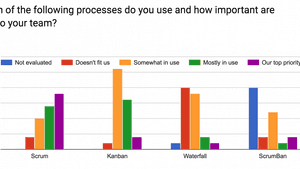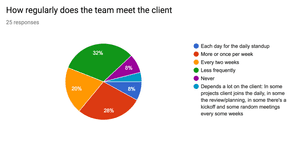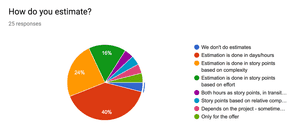Tuesday 31 October 2017
Amazee Agile Agency Survey Results - Part 1
A few weeks ago I published a call for feedback on a project I've begun to assess agile practices in our industry (Take the Amazee Agile Agency Survey 2017). I would like to share a preliminary overview of the results I have received for the Amazee Agile Agency survey so far. Twenty-five individuals have completed the survey to date, so I have decided to extend the deadline a few more days, to November 5th, in order to gather more responses. Thanks to everyone who has participated so far!
INITIAL OBSERVATIONS
POPULAR METHODOLOGIES
Given the initial survey results, Scrum (or a Scrum hybrid or variant) is the most widespread development process used by agencies. Many teams consider it their top priority in order to deliver a successful project. Following Scrum as methods most use by agencies are Kanban or Waterfall. ScrumBan (a hybrid of Scrum and Kanban) has not been widely adopted. In addition to those processes presented, Holocracy, Extreme Programming or DSDM have also been mentioned. At Amazee, we began using Scrum to deliver projects a little over two years ago and have made great progress on it since then. In the last year, we also started a maintenance team which uses Kanban. Just recently, we began evaluating ScrumBan as a way of integrating our maintenance team with one of our project teams.
**PROJECT TEAMS **
Agencies ranging in sizes from 1-5 people to over 100 people have responded to the survey. Of those surveyed, the most common team size for project work are, in order from most common to least common:
- three people or fewer
- five people
- four people
- six people
In terms of co-located or working remotely, team location varied wildly, but skewed towards 'mostly co-located' with some degree of remote. More than 50% of agencies form a new team with the launch of a new project, followed by stable teams which deliver multiple projects at the same time. Following multiple-project delivery are stable teams which deliver one project at a time. At Amazee, we started out spinning up a new team with each new project, but soon realized that the constant starting and stopping of mid-sized projects was too disruptive. These days, we use stable teams to deliver multiple projects.
SPRINTS
Most teams surveyed deliver in two-week sprints. The remaining 33% of respondants deliver anywhere from single-day sprints to month-long sprints.
TEAM INTEGRATION
Frontend and backend developers are usually specialized but mostly work together on one team. DevOps, QA/Testing, as well as the Scrum Master role, are shown in all variations of integrated or totally separate teams. UX & Design are split, with this role either in a separate team (or external resource) or as part of a stable team. At Amazee, we try to hire T-shaped experts that can work across most disciplines on a team. For example, a Frontend developer may also have experience with backend tasks, which can help alleviate work silos and ticket bottlenecks.
STAYING CONNECTED
Most agency teams rely on written communication to stay connected. This can take the form of tickets or via a chat tool such as Slack. The majority of teams hold team meetings and 1-on-1 meetings, while fewer teams communicate mainly via blogs, wikis or even pull requests. The majority of standups last fifteen minutes while some are only 5-10 minutes. At Amazee, our hubs differ. Our Zurich office holds a company-wide standup that takes about ten minutes, followed by a team-specific standup that takes another ten minutes. Our Austin office holds a company-wide standup, which includes a client, which lasts about fifteen minutes.
**SPLITTING UP THE WORK **
Many agencies vary in their approach to defininig, writing, reviewing, and estimating tasks and tickets. For most agencies, the project team is involved in each step of the ticket creation process. In others, creating tickets falls to the client, project manager, or product owner. In most cases, a technical lead is involved in the high-level ticket creation and the team is brought in for estimations. The most common approach to estimating ticket is time based (hours, days, weeks) followed by story points (t-shirt sizes, fibonacci sequence)
**CLIENT COMMUNICATION **
When it comes to meetings between the team and the client, the top mentioned options where 'less frequently' followed by 'more or once per week' and 'every two weeks'. At Amazee, depending on the project size, our teams meet weekly or bi-weekly with the client. Clients are encouraged to talk directly with the team via Slack. We'd like to offer a daily standup with some clients, but haven't figured out how to do this easily as usually a team works on multiple projects at the same time.
DELIVERY PRACTICES
Most teams surveyed deliver rolling deployments, pushing code whenever necessary. Peer reviews / code reviews have been named equally “somewhat in use” as well considered “very important”. While the majority of agencies considers user testing very important, for automated testing the majority still tends only towards “somewhat in use”. While a number of agencies have pair programming somewhat in use, Mob programming is mostly unknown. The majority of teams consider automated deployments / continuous integration very important. When it comes to story mapping, most agencies are unfamiliar. Those which do implement this tool, however, consider it very important. At Amazee, peer review for every ticket is a normal part of our development flow. Our developers implement pair programming whenever necessary. This is an excellent practice for sharing knowledge and increasing the team's technical confidence. We are actively exploring story mapping.
TAKE OUR SURVEY
This initial post is just a taste of the information I have collected, there is a lot more to be shared. Besides the numerical data, I am especially excited about the free-form responses which give valuable insights into the tangible, real-world decisions that are being taken in agencies to define daily agency life. Before sharing a deeper analysis and the full, anonymous, survey results, I wanted to share this preliminary data to give an idea of what’s coming in. I hope this information is helpful in determining industry alignment or to find inspiration for what to try next. Our Agile Agency survey will remain open until Sunday, November 5th at midnight UTC -7. After the survey closes, I will tabulate the results and prepare Part 2 of this series where I look forward to sharing my findings.




